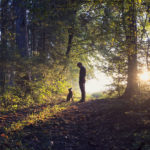In the summer of 1998, I returned home after my freshman year of college only to learn that my job as first mate on my father’s fishing boat had been taken by someone who was younger and fitter and had a better work ethic: my brother, Kenny. To my knowledge, there were no unions for oldest sons of fishermen, so I accepted the loss and settled into my role as the backup. Whatever, I told myself. He’s the one who has to wake up at 4 a.m., and those are no hours for a dignified college man like myself.
I put on my floppy bucket hat and set out to figure out the next step in my career.
By then our little sliver of southern Maryland was booming. A McDonald’s had opened about 20 minutes from my parents’ house, and so had a Pizza Hut, and so had a Subway sandwich shop, where—I don’t mean to brag—I knew a few sandwich artists. As kids we could only dream of eating at chains like this. We had one Burger King during my youngest years, and the only other fast-food spot was a local shop called C&D Carry-Out, run by an old man who never met a kid he didn’t accuse of stealing.
I drove toward all of those bright lights and turned right, headed toward the brightest of them all, a new branch of the pizza chain Domino’s. I had a connection there, a friend who was a delivery driver who helped me get hired on the spot. The manager sent me home with a blue-and-red striped shirt and told me to come back the next day. “You should probably wash that,” he said.
The uniform was too big, but in my mind I still looked like a pro when I returned in my white Ford Escort. I don’t remember receiving training, but I couldn’t have been there more than three minutes before I learned the first rule of pizza delivery: When there’s nothing to deliver, you fold pizza boxes.
“I need stacks,” the manager said. “Gonna be a busy night. I can feel it.”
I was in no position to question his instincts, so I folded. Going on the assumption that most of you haven’t experienced the feeling of fulfillment that comes from folding a Domino’s box, I’ll outline the steps: It’s born as flat cardboard. You flip it upside down to start, fold the top down at the crease, fold it back at the other crease, tuck the little corners in at the other creases, and fold the flap down until you’re out of creases.
Soon after you’ve added a few boxes to the stacks, you might hear the manager holler your name. “Mike! You’re up!”
I remember running to the front to meet the manager, a short but blunt fellow in his early 20s named P.J., who fired instructions at me like a quarterback in a huddle.
“OK! Bensville Road! Got it?”
Shrug.
“It’s one of the main roads, man. Come on. Didn’t you grow up here?”
“Well, yeah, but I’ve been away at college.”
“Did it make you stupid?”
He raised his arm toward the map on the wall. I’d never seen home look so big. He’d taken the book of county road maps, torn out every page and put them together like a puzzle. Our coverage area included western Charles County and southern Prince George’s County. If you don’t know where that is, you’re not alone. It’s about a 30-minute drive south from Washington, D.C., along the Potomac River. The roads in this part of Maryland go where the land and water allow, the highway shooting down the middle of the main peninsula, offshoots curving around coves and creeks. It’s the forgotten part of the D.C. metro area, a place few people who live in the District can even point to.
“I’ve given a good bit of thought to why we romanticize our first jobs, and after reading countless other tales, it’s clear that Americans are obsessed with creating a story arc for our lives.”
“Here it is, man. Bensville,” P.J. said, running his finger along the wall. “And the house should be here,” he said with a short finger jab on the map.
He stuffed the two pizzas in a red warmer bag, put a six-pack of Coke on top, and said, “Go.”
***
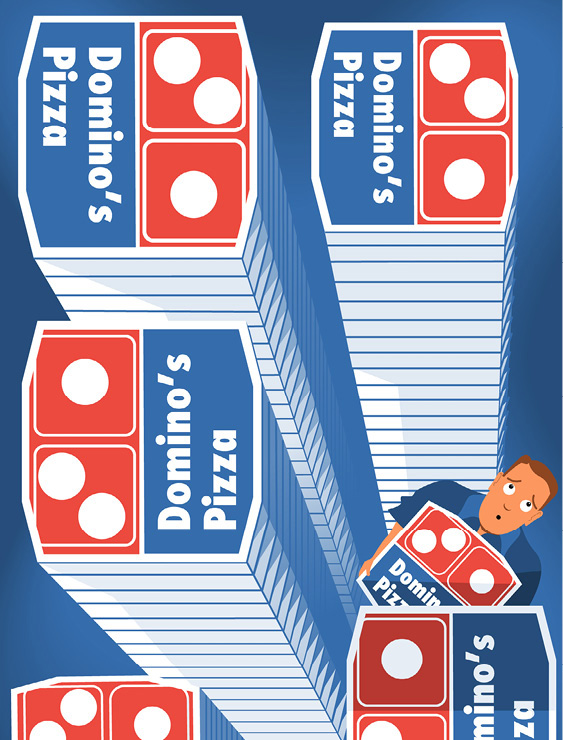
JOHN TOMAC
A couple of years ago, the hashtag #FirstSevenJobs was trending on Facebook and it identified the most common first jobs. Baby sitter was No. 1; pizza delivery was No. 18.
The Domino’s position was actually my third job. I’d worked on my dad’s boat off and on since I was a young teen, helping with big parties or through commercial fishing season. That was an under-the-table gig, though—sometimes he paid with a nice lunch. My first real job in the eyes of the government was working at a movie theater. For $4.25 an hour, I took tickets, made popcorn and occasionally loaded a movie reel (we still used film) during my senior year of high school.
I was one of about 9 million young adults ages 16 to 19 in the workforce at the time, according to labor statistics from 1996. We made up about 6 percent of the total workforce then. Twenty years later, in 2016, the number of 16- to 19-year-olds with jobs had dipped to 5 million, or just 3 percent of the total workforce. Kids today!
I’ve given a good bit of thought to why we romanticize our first jobs, and after reading countless other tales, it’s clear that Americans are obsessed with creating a story arc for our lives: I came from this, and I became that. Beyoncé swept floors at her mother’s hair salon; Madonna worked at Dunkin’ Donuts; Michael Dell was a dishwasher at a Chinese restaurant; Warren Buffett, a paperboy. And look where they are! We like to believe that we can make it from here to there, and we like to believe that where we are is better than where we’ve been. Hopefully that’s true.
A few weeks ago I went to the library and checked out Pizza Tiger, the biography of Domino’s founder Tom Monaghan. It’s hardly a literary piece, and it plays up predictable themes in its jaunt to explain how he built the world’s largest pizza-delivery chain. There’s…
Adversity at the beginning: Before he bought what would become Domino’s, Monaghan says a man who claimed to be an oil investor stole $1,500 from him.
The big risk: Not long after that, he and his brother bought a pizza parlor called DomiNick’s in Michigan in 1960. The cost was $500 plus a few thousand in debt.
A little fun along the way: After the Tigers won the World Series in St. Louis in 1968, Monaghan and his staff drove toward the Detroit airport to greet the returning team with pizzas. Traffic was so bad they never made it, so they just stopped and sold the pies to all of the cars stuck on the highway.
Mistakes: He once got drunk and accidentally knocked over the Christmas tree and jumped up and down on it in front of his wife and newborn.
And lessons: He never drank again after that.
And a happy, rich ending: “I couldn’t deliver a pizza now; I no longer have a driver’s license. I didn’t bother to renew it because a security man drives me everywhere,” he writes in the final pages.
That’s the man who paid me less than $3 an hour plus tips for two summers. I don’t think I minded then, but I know I don’t now. If for no other reason than the job led me to make one delivery that changed the way I saw the world.
***
Growing up in that rural area, my schools were about 50 percent white and 50 percent black. Nobody was wealthy. My mom was a first-grade teacher and my dad was a fisherman, and we had far more than most.
My education on class disparities came after I took a scholarship and enrolled in a private college in North Carolina. Our high school parking lots had been filled with beat-up Toyota Tercels and Ford Rangers. The college lots were different. I remember calling home during my first month at school to report the scene: “There are BMWs everywhere!” I said. And I remember my mother’s response, as clear as if she said it this morning: “Well,” she said with a huff of air, “I’m sorry, Michael.” It was a sarcastic reminder to be grateful for what we had. I’m 38 years old now and I still hear her words when I become envious of others. There’s always something to be envious of, right?
I’m certain we had more pizza than most kids. Had it every weekend, in fact.
Our house was too far back in the woods for delivery services, so we always drove to pick it up. Some of my earliest memories are of cutting through dark two-lane roads in my mom’s black station wagon, coming home from an old pizza spot near the library where I learned to read. We’d take home a pepperoni, peppers and onions pizza and watch Golden Girls. I still think of those green peppers whenever I see Betty White.
Sometimes we ate out. About 15 minutes from our house was Star Pizza. Its pies were thicker, and they came out hot. I used a knife and fork, and I truly don’t care what you think of that. Star also had two of those arcade games where you’d sit down across from your opponents, and Kenny and I drained all of the quarters we could into Frogger or Pac-Man while we waited for dinner. I can still taste the fizz of the fountain soda in the back of my mouth. Star was also where we had end-of-season Little League parties. The fact that a gambling ring ran out of the back of the restaurant was lost on us.
The gold standard for any Marylander was Ledo Pizza, which serves rectangular pies because, wait for it, “we don’t cut corners.” We had to drive an hour to the closest Ledo; it was a special-occasion type of place.
As restaurants opened and closed, we chased pizza all around. No matter what happened in the week, we always knew that a weekend night together, the four of us with cheese and dough and sauce, was waiting.
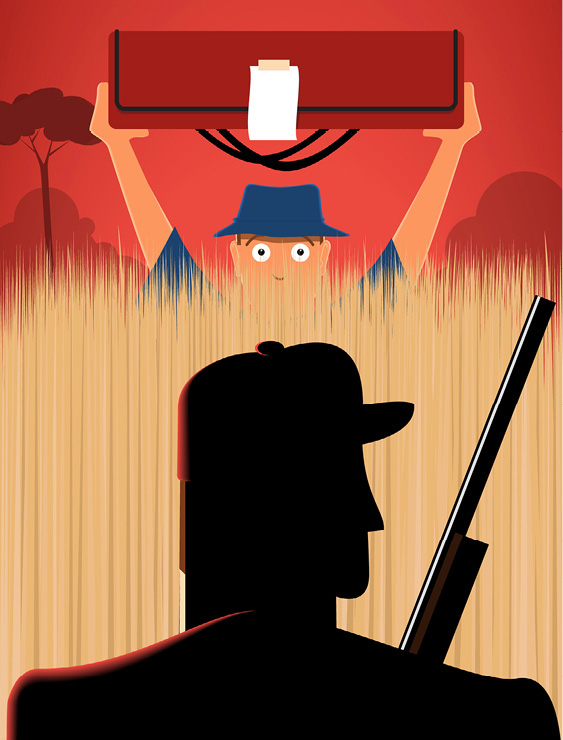
JOHN TOMAC
***
I never knew what was behind the next door. One minute, I’d be walking through the barracks on the small Navy base in town, waiting for some guy with a buzzed head to poke his head out; and the next I’d be at the house of an old lady who’d yell, “Come on in!” because she didn’t feel like getting up.
We’d get calls from dove hunters who’d tell us which side of the field was safe to enter. Or people living in extended-stay motels. Or the gun-making factory, where managers occasionally called in orders of 10 or 12 pies for the third-shift workers.
For me, the job was a natural transition from fishing. We’d all return from our deliveries and head to the back to fold boxes and unload what we’d seen.
It’s been years since I’ve talked to those people, but I remember their names. There were Wayne, Reed, Keith, Kara, Darren and a couple of Billys. And of course Big Kirk, maybe the funniest of all, may he rest in peace.
Looking back, I’m not sure which stories are true and which stories aren’t, the years blending them together. Big Kirk had one about getting robbed, which made no sense to me because Big Kirk was big. We got snipped at by dogs, hissed at by cats, and we startled the heck out of a few of our former teachers who were clear-eyed by day but came to the door with pink eyes at pizza time. Wayne told one story of being greeted by a woman wrapped in a towel. Naturally, in Wayne’s version she placed the pizzas on the table and opened the towel just for him. Whether he was full of it or not, he got the reaction he wanted most. “No way.”
Sometimes I’d meet up with my best friend, Joey. Don’t tell anyone, but he delivered for Pizza Hut. Sometimes we’d race, he in his purple Ranger and me in my white Escort, making the most out of the eight cylinders we shared between them. Other times we’d just sit in neighborhoods and talk, or have a beer sitting on the back of his truck.
(Side note: Other pizza delivery folks have proved to be better citizens than we were. Some are heroes. At least twice in the past seven years—once in Oregon and again in Tennessee—drivers voluntarily went to the homes of regular customers who were elderly and had stopped calling, only to find those people had fallen and couldn’t reach their phones to call for help.)
Some of my favorite times were just being alone, driving. We didn’t have GPS or cellphones, just maps and music. I rode all around those dark roads with Bruce Springsteen’s greatest hits and Biggie Smalls’ last CD, Sublime and the Barenaked Ladies, and Tom Petty, of course.
I’d fly back and forth across the county, around turns that suddenly I knew better than anyone else—the big curves on Billingsley Road, for instance, where so many other kids wrecked their cars. I knew the top speed you could travel without winding up in a tree.
The most dreaded word was closing. It meant that you had the last shift, and the last shift meant dishes.
The Semisonic tune “Closing Time” came out the spring before I took the job, and the old DC101 radio station loved that song. I remember spending long nights in the back, holding down the trigger on the sink faucet nozzle, the sound of clean water spraying down on the dishes, the smell of dirty pan water rising up, and that song, “Closing Time,” all around.
One Friday night I was closing when a call came in to take a pizza to the Navy base. These people were our age or just a little older, and often they’d order one pizza at a time and barely tip. The gate was 7 miles away, and after getting through that, the speed limit on base was 25 mph. Each trip took at least 30 minutes, there and back, and often you’d leave with little more than a buck in your pocket.
That night around 10 p.m., the base was one of my last runs. I passed the guard with a wave, which was all the permission we needed before 9/11, and coursed my way to a section of townhouses. Near a park, a tiny beagle ran out from the left side of the road. I remember its eyes shined green when it looked at me, and I remember the thump. I stopped. My hands shook and tears spilled out of my eyes. And then, for reasons I still can’t understand as anything other than panic, I went on and delivered the pizza. By the time I got back to the spot, a military police officer had blocked the road. A woman was kneeling in the grass with two young kids, crying and pointing at me. The officer approached my window. He checked my license and registration and said, “It’s OK. It happens. Just go on.” I did what the man said, but I still wonder about that family. The kids would be in their late 20s now, maybe with children and a dog of their own.
I mention the story now not because it’s the delivery that changed the way I saw the world. That’s coming. But I wanted to mention it on the off chance that one of them happens to read this. If so, I’m still sorry.
***
Today—and I mean literally the day you read this—one out of every eight Americans will eat pizza, according to a recent study from the U.S. Department of Agriculture.
My wife and I live in a nice neighborhood in Charlotte, North Carolina, where she grew up. Her first job was as a baby sitter, followed closely by a position at a nursery and greenhouse. She now has a successful career in public relations but she’s still a wizard in the soil. For all the energy we spend going from there to here in our stories, it seems we never venture too far from the opening scene.
“The delivery I’ll never forget started like any other.”
Like my family did when I was a kid, Laura and I eat pizza once a week. From our front steps, we can walk to three places with “pizza” in the name, and a half-dozen others that have pizza or flatbread on the menu. We’re so spoiled that we have a different pizza place for different moods. One restaurant, run by Serbian brothers, has brick walls and warm air and is ideal for cold nights. Another has solid pizza and long tables and an outdoor area where our friends’ kids can run on summer evenings. Another has fancy, organic toppings. A short drive away are two new Neapolitan-style places with super ovens that bake pies in 90 seconds. About 2 miles away is a restaurant that’s located down a set of stairs, hidden away, with a grilled sweet Italian sausage pie that’s our favorite pizza in the city. Of course it helps that our tax guy is also the bartender there. But when we want to eat our way back in time, we go to a place called Luisa’s. It’s just a few blocks from where Laura grew up. When her mom would get home on Fridays after a week of work, she’d take Laura and her older brother to Luisa’s.
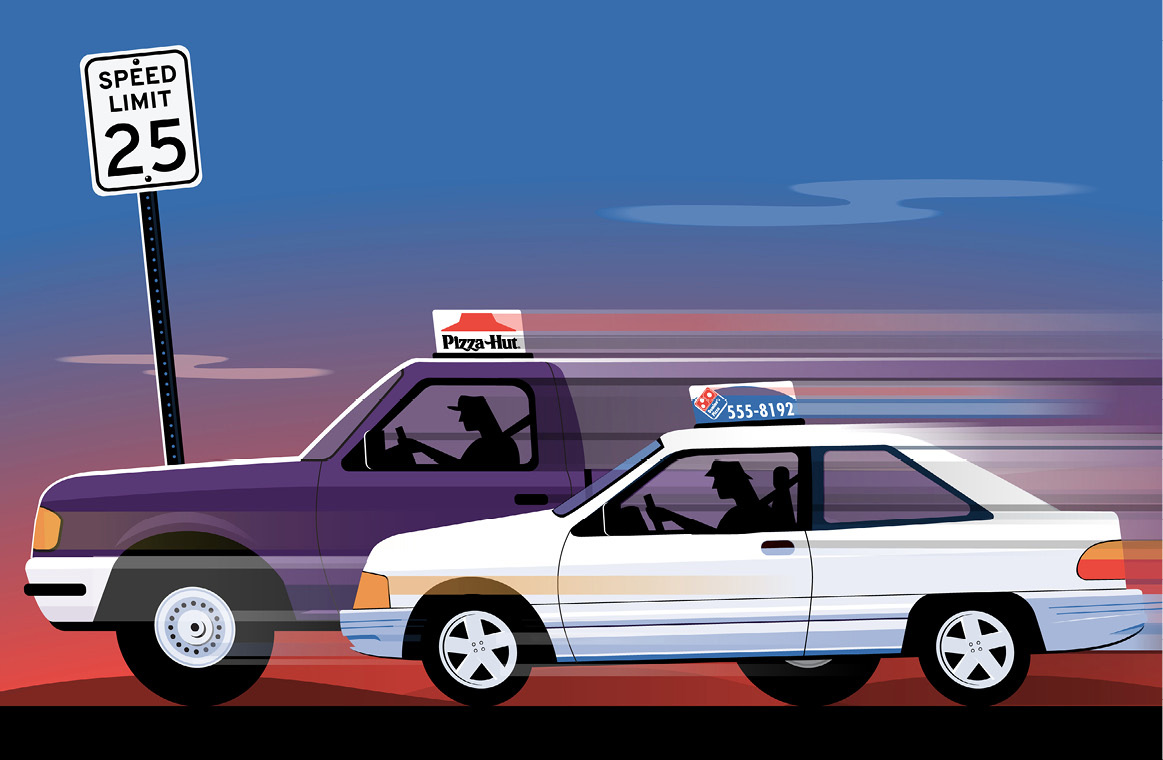
JOHN TOMAC
It’s a good 15 minutes from our condo, but that’s where we went the other night. We called in a large with pepperoni, mushrooms, onions and green peppers—all dropped on a crust that turns a little floppy after it’s done cooking in a brick oven. Above the oven is a sign that counts the number of pizzas cooked here since the restaurant opened in the early 1990s. On this night, the number was 1,335,072.
“Y’all just added to that,” a waitress said as we walked out. We dropped the box in the back seat and steered away, the smell of cheese and sauce filling the car as we passed 11 pizza restaurants between there and home.
***
The delivery I’ll never forget started like any other, P.J. calling me to the front and handing me a ticket with the order and address. I recognized the street immediately: Bertha Circle.
It was in Woodland Village, the only neighborhood in the delivery area that had a reputation as dangerous. The summer before I started working at Domino’s, a driver was robbed at gunpoint there. It made the paper. Most of my co-workers had tales of being robbed or nearly robbed. Looking back, I’m certain they weren’t true.
In our humble area, this was one of the poorer neighborhoods, and this was my first time going into it. I picked the pizzas off the rack and ran to the car, not wanting to risk being late. About 4 miles into the trip, I was at a stoplight when I looked at the ticket and realized that the order called for a six-pack of Coke. I remember my head got warm as blood rushed. I didn’t know what to do. Go back and be late to what’s surely a house full of people who’ll probably rob me anyway? Or go forward to that house without the Coke? I came up with another plan: I stopped at the Dash-In convenience store and purchased six 20-ounce Coca-Cola bottles.
I’d already started to form a theory that people with less give more. The only gated community we delivered to was at the northernmost point of our delivery area, as close as we got to Washington, D.C.. It opened in the mid-1990s, and one of the first residents to buy a house there was a new Washington Redskins receiver, who had just signed a big contract with the team as a free agent. The first summer I delivered, he lived in a 5,500-square-foot house on a corner in that gated community, and he taught me that even millionaires are bad tippers.
I turned left into Woodland Village, this notorious neighborhood of short and square brick homes, and I passed people sitting on porches and clotheslines full of bright colors. I found the house and clumsily gathered the bottled Coca-Colas and pizzas. A man answered. I’ll never forget what he looked like; he looked like every other dad I knew. He was trim and had a pair of glasses perched on a nose that hung over a mustache. Two young children played in the living room.
When I handed him the order, he said, “What? Did you guys switch to bottles?” I told him the weak story of how I’d forgotten the cans and purchased the bottles. He thanked me, shut the door and I drove away.
Back at the store, the manager handed me a slip of paper with a phone number on it.
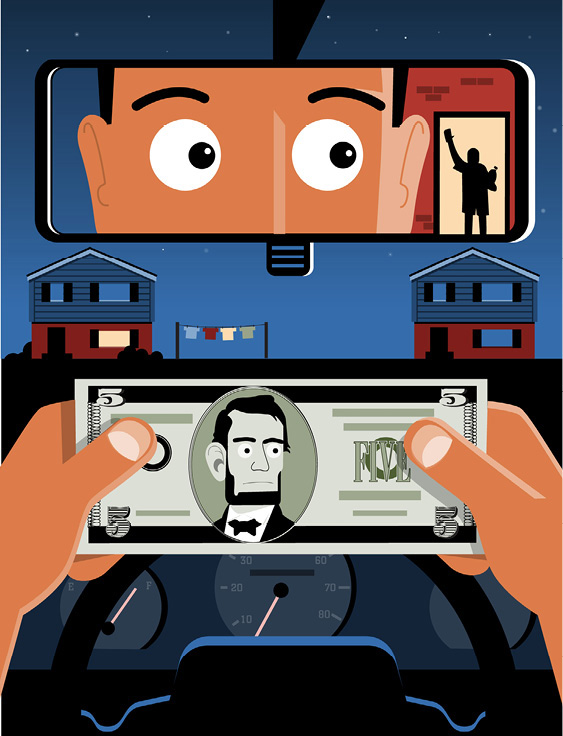
JOHN TOMAC
“Whoever you delivered to just called and wants you to call him back,” he said.
I dialed the number and the man from Bertha Circle answered.
“If you’re back down here later, come by,” he said. “I want to pay you for those sodas you bought.”
Later that night, it was dark and I had another delivery in that area. On the way back I pulled into Woodland Village and drove past the people on porches and the clotheslines full of bright colors. The man in that bad neighborhood gave me money to cover the sodas, then a $5 bill on top of that. And then he thanked me.
“Most of my co-workers had tales of being robbed or nearly robbed. Looking back, I’m certain they weren’t true.”
“Hope to see you again,” he said.
I never delivered another pizza to that house, but I thought of him whenever another ticket popped up with a Woodland Village address. And I still think of him, 20 years later, in my work in the Charlotte community. A few months ago I joined a group of 30 or so others—politicians, lawyers, heads of business—of all different races and backgrounds for an implicit-bias roundtable. We each were asked to list words we’d heard about each other’s cultures as kids, and to do it honestly. As we went around the room, it was apparent that we’d all learned some things we’ve had to unlearn. At one point, the image of that man from Bertha Circle popped in my head.
When he called me back to his house that night, he wasn’t just giving me extra money; he was giving me a couple of lessons: First, it’s senseless to sort people into groups before you know them as individuals. Second, show people how much you think they’re worth.
To this day, no matter what, I’ve never given another delivery driver less than a $5 tip.
I drove out of the neighborhood that night and turned the headlights down the highway toward the shop. I opened the door, hung the warmer bag on the rack, and went to the back to fold boxes.
The manager walked by to grab a stack. “Hey, Graff, what’d that guy from Woodland Village want?”
The other drivers turned their eyes toward me.
Nothing. He just wanted to give me a bigger tip.
“No way.”
This article originally appeared in the March 2018 issue of SUCCESS magazine.





